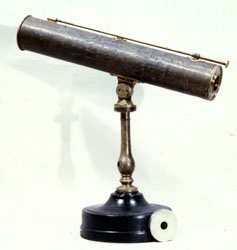 35. Gregorian telescope by J. Sisson
35. Gregorian telescope by J. Sisson
It appears for the first time in the inventory of 1746, with no indication as to provenance: it might be part of the English instruments ordered by Manfredi [files 14, 17 and 19].
There is also a description of it in Ceschiís inventory of 1843: "Gregorian telescope, i.e. with two parallel mirrors, both concave, made by Englishman J. Sisson. It consists of a one-foot metal tube, covered in black skin, supported by a metal column screwed onto a wooden base, under which are attached three metal hooks. The column is jointed to allow horizontal and vertical movement. The direct image eye-piece crosses the large mirror. The 2-inch diameter aperture is protected by a metal cap."
Manfrediís interest in this type of mirror telescope seems to have been excited by certain letters the papal archiater Leprotti sent him (Lib. Archiginnasio Bo., Fondi Speciali Leprotti, 6 and 13 January 1731) which spoke of the excitement this new type of instrument had aroused in Rome at that time.
The Scottish mathematician James Gregory (1638-1675), in his Optica promota (London 1663), had suggested replacing lenses, used until then as objectives, with two concave mirrors, coaxial and parallel, mounted in such a way that the respective focal planes coincided. In practice, this kind of optical system consisted of a primary parabolic mirror and a secondary elliptical one so as to eliminate spherical aberration. Unlike the Newtonian and Cassegrain systems, the image provided by the so-called "gregorian telescope" was a non-inverted image. This and the easy convenience of the instrument meant it was widely used in the XVIIIth century.
The eye-piece is missing. The base - that we know was made of black wood - and the focusing screw have been restored (S. Ciattaglia, Bologna, 1990). The shark-skin covering has almost disappeared even if fragments were found during restoration.
The Specola had already owned a metal-mirrored telescope, focal length approx. two feet, made by the Englishman Samuel Molyneux (1689-1728). This telescope, with Newtonian-type optical system and silver finishing, had been given by the Prince of Wales to the King of Portugal, and by this latter to Francesco Bianchini who left it to Cardinal Davia who in turn donated it to the Institute of Science. Molyneuxís telescope appeared for the last time in the inventory of 1843 (see Baiada and Braccesi ( op. cit. p. 90 ) for details on this telescope and the correspondence in this regard between Bianchini and Manfredi).
E. Baiada, A. Braccesi (1983), p. 119.
E. Engberts (1970), p. 23, fig. 7.
D. Howse (1993), p.608.
D.P. Wheatland (1968), p. 13, 15.